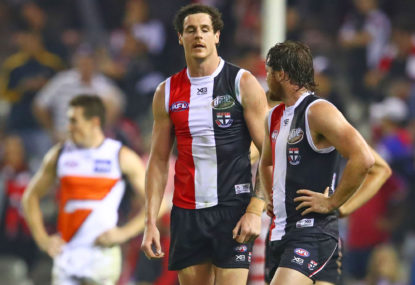The Bombers and Saints had grand designs for 2018. What has come to pass is something far less attractive. So, what do the two clubs do now?
Each team has 15 games to go; we’re roughly one third of the way through the season. The distribution of wins to date has been fairly egalitarian around the middle, with a couple of outlier teams at the top and bottom. The ‘middle’ stretches from fifth to 11th, with seven teams on four wins (the Giants also have a draw) and percentages of greater than 100.
That part of the ladder is set to be congested for most if not all of the season. Each team in there has had its share of stirring wins and shocking losses, a pattern that will if maintained will conspire to keep the group tightknit all year. Living above the fray will be a challenge, but Richmond, West Coast, Adelaide and Hawthorn have an extra win and some points of percentage on them all.
Equally, teams below start the second third of the season with a significant handicap. This is of particular concern for St Kilda (1-1-5, 69.8 per cent) and Essendon (2-5, 83.7 per cent), who face the daunting prospect of clawing back at least eight premiership points and at least 20 points of percentage just to draw level with 11th place. The task for the Saints is even more challenging.

(Photo by Michael Willson/AFL Media/Getty Images)
Just to get to 12 wins – the new price floor for a finals spot in the 18-team league – St Kilda will need to win 11 of their next 15 games; the Bombers 10 of 15. And that is to reach the minimum benchmark; the price of a September ticket could well stretch beyond 48 premiership points in 2018. Given their respective showings, that is as likely to materialise as someone, anyone, beating Richmond at the MCG.
So what happens now?
It is certainly not the time to panic. The football gods afford us eight finals places and one premiership to split between 18 of their children each year. Even if every team was of a high standard, the brutal maths of the league is what it is. So, do not despair on that front.
It may be time to – in the words of Alastair Clarkson, and dammit I’m going to use this phrase until it is part of the vernacular – consciously decelerate for 2018. That isn’t tanking, but it is taking a conservative approach to injury management, giving some prospective youngsters larger roles, and spinning the magnets a little more loosely than otherwise.
In the medium term though? There are some aspects of both game style and list that need to be addressed, which you’ve already seen and read about over the past few weeks. By necessity we’ll cover them off, before looking at what comes next.
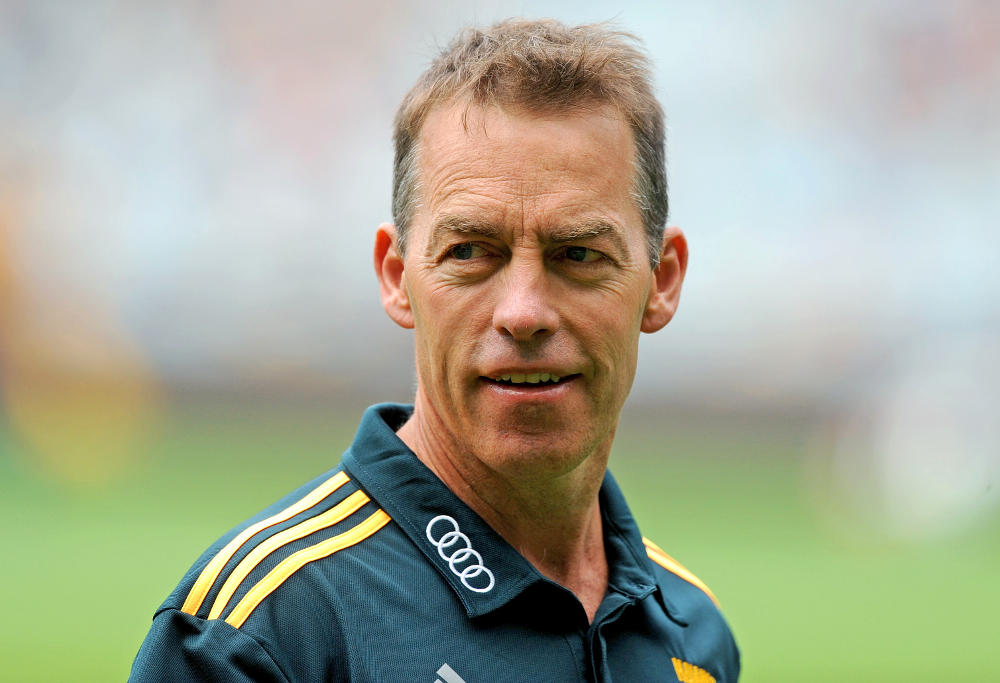
Hawthorn coach Alastair Clarkson. (Image: AAP Image/Joe Castro)
A common thread
Both Essendon and St Kilda have something in common: they are breaking down forward of centre.
One word comes to mind immediately to describe Essendon’s football in 2018: listless. And in a league that is demanding pace, space and pressure, that is the worst way to describe how a football team plays.
Essendon play with the urgency of a nest of turtles that has made its home on a deserted island. There is nothing creative, daring or exciting about how they move the ball between the arcs, and indeed they appear to relish their slow play stylings.
We see this play out in one key statistic: inside 50 entries. The Dons have recorded just 47.6 per game in 2018, the fewest in the competition and a frankly stunning 12.1 entries less than the league-leading Richmond. It’s happening for three reasons, which conspire to produce the listless descriptor: a weak inside midfield division, dicking around with the ball between the arcs, and a lack of forward pressure.
They have been beaten at stoppages in five of their seven games, and have a season-long differential of -1.6 per game (not the worst, but a ways off the best). Essendon’s on-ball division has relied on Dyson Heppell, Darcy Parish, Devon Smith and David Myers (in recent weeks) to shoulder the inside load, and it’s not clear any of the trio are really suited to that work.
In an ideal world, the first three names are the guys on the receiving end of the work of someone else. That the Bombers are breaking even in the ground game is a minor miracle, but also helps explain their poor ball movement.
Essendon are the third worst team for converting possession into territory, recording an inside 50 per minute of possession rate that’s 6.6 per cent below league average. They also have the fourth worst time in possession differential in the competition – the two teams below them on territory are Adelaide and Geelong, who hold the ball longer than any other team in the competition.
When moving the ball between the arcs, Essendon regularly get caught on the wings or attacking side of the centre square, apparently waiting for the perfect option to materialise. They handball, handball, handball circle themselves into trouble, and turn the ball over. Theirs is the second highest rate of uncontested possessions per minute of possession in the league (4.98), a sign of how slow they’re moving the ball.
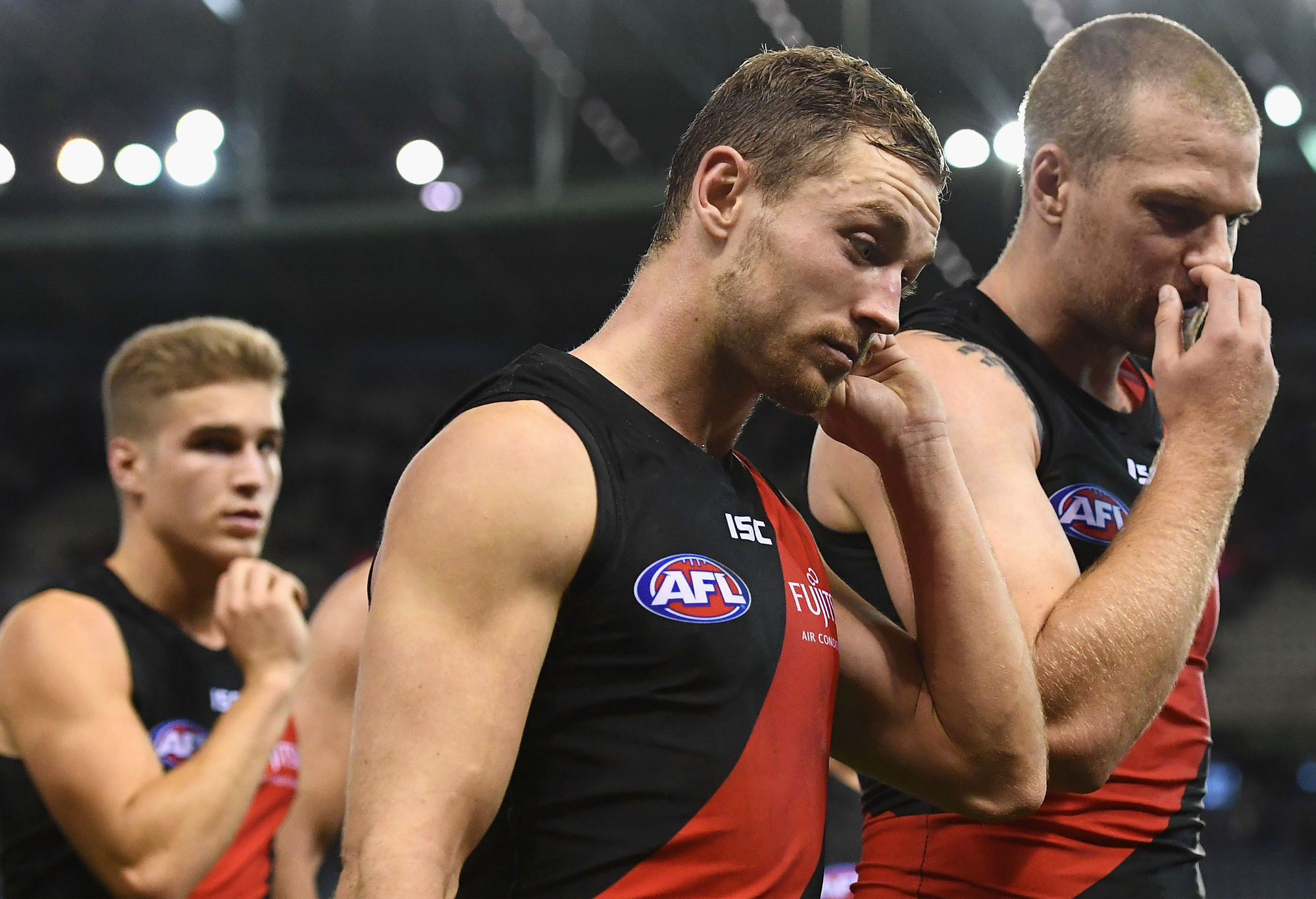
Devon Smith and Jake Stringer of the Bombers (Photo by Quinn Rooney/Getty Images)
In short, they’re playing a game both ill-suited to their midfield personnel, and ill-fitting with how the league has moved over the past two years. They can’t blame injuries or absence either, with the only injury that may have been affecting their style of play in the first seven rounds being Orazio Fantasia; that will change from this week with Joe Daniher going down.
Unfortunately for the Dons, it’s something of a negative-virtuous circle, that will take a significant shake-up to correct over the next few rounds. Double unfortunately, Essendon play Geelong, Greater Western Sydney and Richmond in Rounds 8 through 10.
The very least the Bombers can do is substitute some of the hospital handpasses for kicks, affording the recipient of the ball a few breaths to make a decision what to do next. Some more faith in the forwards group to manage the ball once it’s in their half of the ground would also help; the teams around the top of the ladder are showing that pace is the flour in a quality football cake in 2018.
That’s to say nothing of Essendon’s inability to stop their opponents from scoring once they enter their attacking 50. For all the talk of the Bombers’ challenges in attack, they’ve currently got the third worst defence in the competition conceding 97.1 points per game. Essendon’s opponents are scoring on 52 per cent of entries, the worst mark in the competition. To add a little insult, no individual team comes close to scoring at that rate on average, suggesting everyone has a field day against the Dons. Yuck.
St Kilda have been pulled apart multiple times this year so we’ll save some inches here. They have the opposite problem, although it manifests in the same offensive impotency: they are a frantic, disorganised mess, freewheeling and improvising when they haven’t the cattle to do so.
The Saints are getting enough supply down the pointy end of the ground (51.9 inside 50s per game, only one below the average), but they’re scoring just 41 per cent of the time, and on those attempts are only kicking goals 40 per cent of the time. It’s extraordinary, and it’s costing them about three goals a game vis-a-vis if they’d hit league average.
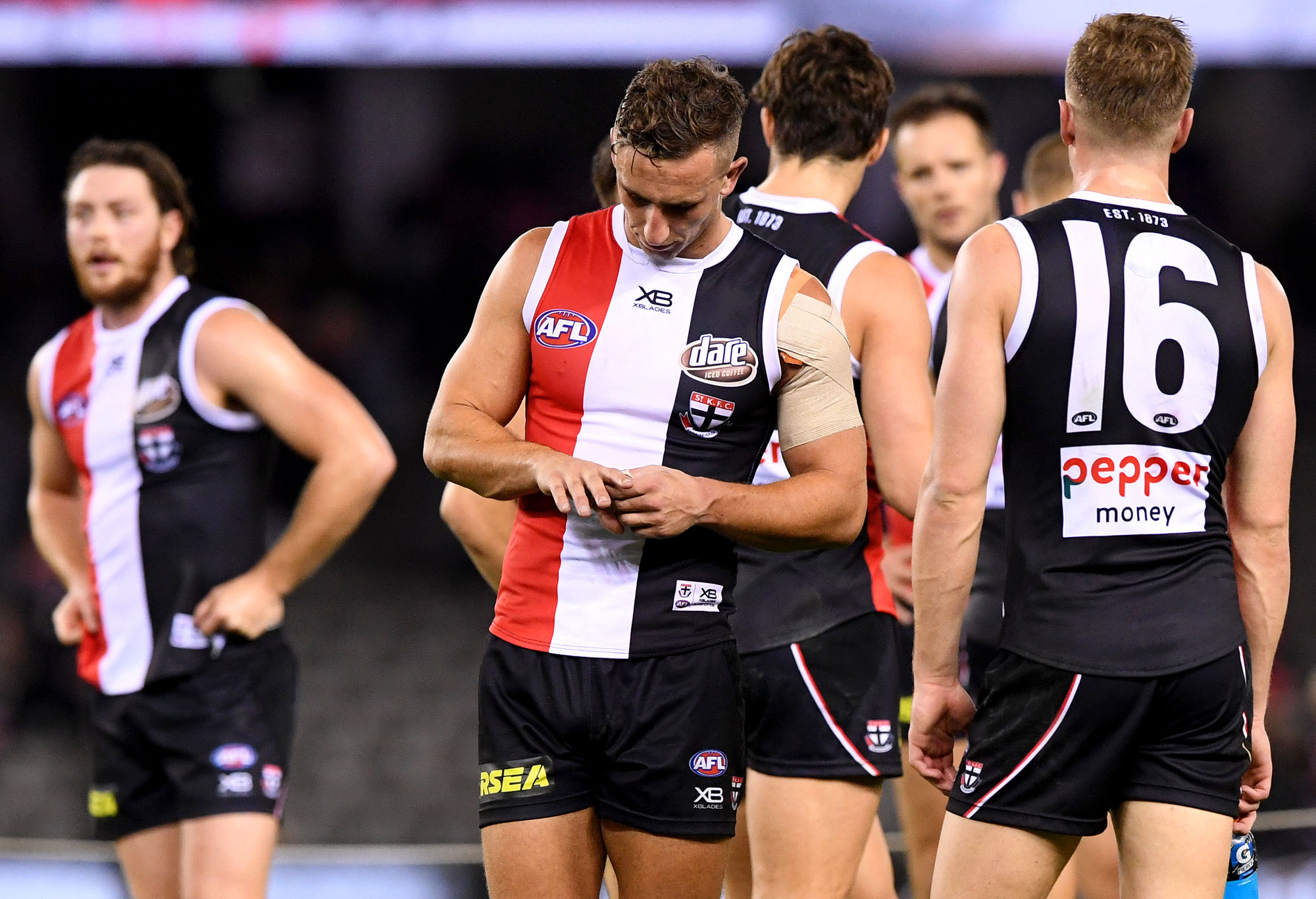
(AAP Image/Joe Castro)
Part of this is luck. But not all of it. Figuring Footy puts the Saints at just minus six goals against expectation on set shots in 2018. Their problem is shot quality. St Kilda rarely look settled inside forward 50, with random leading patterns and difficult shots taken on the run or out of congestion. Unlike the Dons, the Saints would do well to slow down a little, and think through their offence, rather than flailing and failing.
For both sides, forward half pressure has been well below the best in the league. According to figures published in News Limited papers and sourced from Champion Data, Essendon rank third last for time in forward half, and second last in points from forward half possession chains. St Kilda is no better; 15th in time in forward half, and dead last in points from forward half possession chains.
Both sides have clear game style challenges, which are unlikely to be overcome with a quick tweak or two. But there’s still a heap of football left in 2018. They have to do something.
Playing the long game
What they should not do is panic and remove their coach. Neither club. I don’t think this is on the cards, but clubs with high expectations have been known to do crazy things.
For one, the football department spending cap makes it much harder to do so these days. All payments made to coaches – past, present and future – come under the spending cap, and unless clubs are budgeting for million dollar payouts an early coach departure would almost certainly send them soaring over the top. The tax rate is a punitive 75 cents for every dollar, meaning a $1 million pay out would cost a club $750,000 in tax (for example). And that’s money that gets distributed to other clubs, giving them a financial leg up.
According to the AFL’s competition regulations, clubs can apply to have certain payments declared outside of the cap. However one would assume the AFL is unlikely to enable clubs in this way. It’s one of the key reasons I suspect we will see much less abrupt coaching turnover in the league, as well as shorter contracts and much more public messaging from clubs regarding coaches coming out of contract.
Now, would Essendon have rushed to re-sign John Worsfold at the start of the season if it knew these first seven rounds would transpire as they have? Almost certainly not. But that decision is made, and to move on from him early would be costly.
While both clubs need some work in their on-field direction, that is as much down to the assistant coaches and teams of analysts and video folk as the head coach these days. The head coach is like the CEO, setting broad direction and ensuring the team is functioning well.
Both Worsfold and Richardson were re-signed with the best of intentions after showing positive signs in the two and four years prior to the start of this season. Seven rounds of football cannot be allowed to change what came before.
And by the way, playing and coaching Australian rules football is hard work. Both men inherited dastardly situations – a club reeling from off field controversy and a complete list tear down respectively – only to build their teams back up to the middle of the pack. They know what they’re doing.
Richmond was very close to lopping its premiership coach’s head off 18 months ago. Collingwood is now playing the kind of football we’ve all known was possible for a while, and they were about to lop their coach’s head off too. There were rumblings out west earlier this year that Adam Simpson might have his number called at the end of his current contract on account of the club’s supposed rebuild. How quickly things can change.
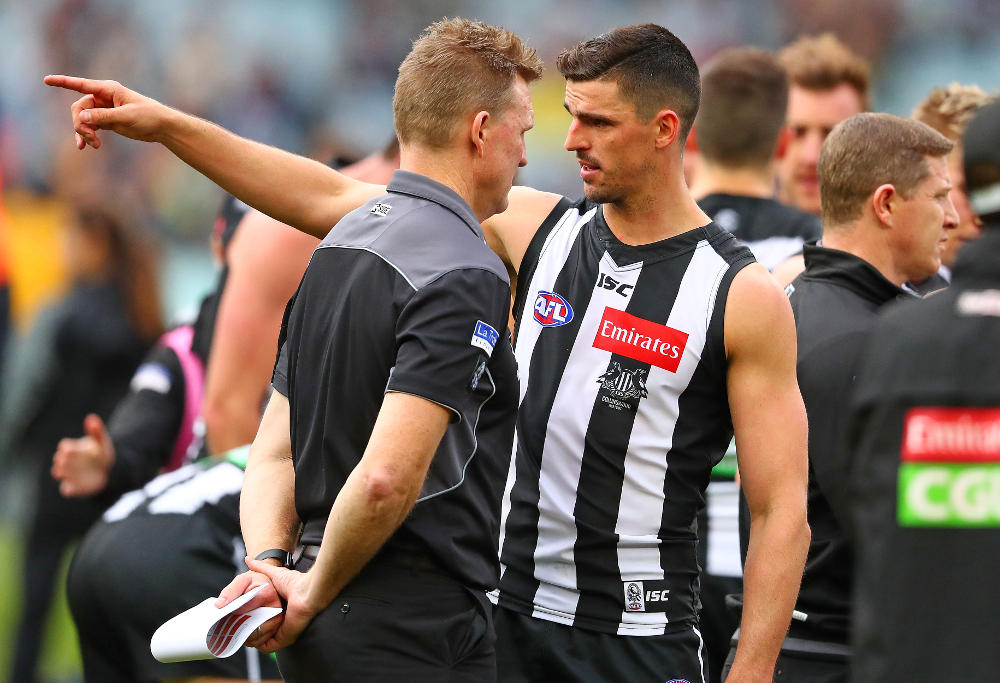
(Photo by Scott Barbour/Getty Images)
Or more significantly, how long it can take for success to manifest. I hate clichés but this one is apt: progress is rarely linear. There are problems, but they can be fixed, and they will be in time. If they aren’t, well, that’s when the executioner comes calling.
Both teams could use some extra talent on their lists, but we’re a ways off considering that in detail. Essendon is short on proper inside midfielders, while St Kilda has a near perfect list bar the top four or six players that help push you over the edge – as a colleague pointed out to me this week, you aren’t winning a premiership with Jack Steven as your best midfielder.
There are options aplenty, both in trade and free agency pools. Both teams would be wise to tap their draft capital and load up with established players that meet specific needs come October time.
Unfortunately for the two clubs concerned, October is still five months away, and there are 15 games of football left to play. They’ll improve. So long as they don’t lose their heads.





























































































